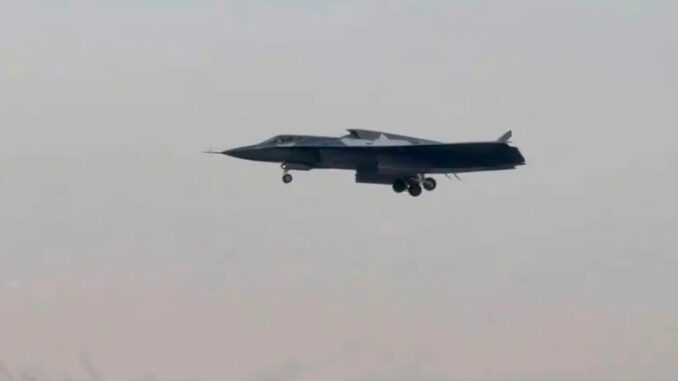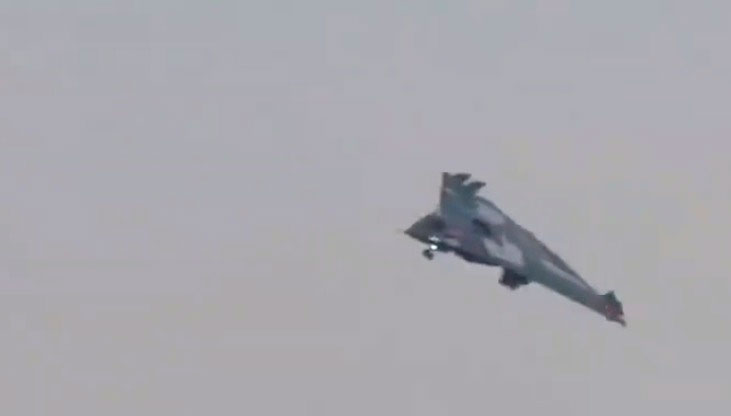
The J-36, the new sixth-generation Chinese stealth aircraft, reveals major technological advances, redefining the balance of global air forces.
A new video circulating on the Chinese social network Weibo offers the clearest view of what appears to be the People’s Liberation Army’s new-generation stealth fighter, reportedly designated the J-36. The images, which were reportedly filmed near Chengdu in the Chinese province of Sichuan, show the plane landing on a site belonging to the Chengdu Aircraft Corporation (CAC), a subsidiary of the Aviation Industry Corporation of China (AVIC). The location and the aircraft suggest that China’s sixth-generation fighter program is currently undergoing preliminary flight testing.
The video shows a large tailless flying wing platform with a distinctive trijet configuration, an unusual feature in modern fighter design. The silhouette of the aircraft features a modified delta wing with deep forward cutouts extending towards the nose, combined with a bulky fuselage that suggests a greater internal fuel and weapon capacity.
The J-36 is the new sixth-generation stealth fighter developed by China. Recently seen on test flights near Chengdu, this aircraft has a tail-less design with a trijet configuration, a rare feature in modern designs. Its design suggests a focus on endurance, payload capacity and stealth, positioning it as a direct competitor to future Western fighters such as the American F-47. This breakthrough underlines China’s ambition to strengthen its air dominance and project its military power beyond its borders.

Overview of the J-36: a revolutionary design
The J-36, developed by the Chengdu Aircraft Corporation (CAC), represents a significant advance in the field of Chinese military aviation. Recent images show an aircraft without tail fins, with a modified swept wing with deep cutouts towards the front, extending towards the nose of the aircraft. This configuration, combined with a bulky fuselage, suggests an increased capacity for internal fuel and armament. The most notable feature is its three-engine configuration, a rarity in current fighter designs, which could offer additional thrust and better fuel consumption management.
Technical characteristics and innovations
The J-36 is distinguished by several technical innovations:
- Tail-less design: This architecture improves stealth by reducing the aircraft’s radar signature.
- Trijet configuration: The addition of a third engine could increase power and range, essential for long-range missions.
- Rear air intake: Located behind the cockpit canopy, this unusual air intake could improve stealth characteristics and optimize airflow management during high-altitude, high-speed operations.
These characteristics suggest that the J-36 is designed for missions requiring prolonged endurance, significant payload capacity and low detectability, making it suitable for operation in contested airspace.
Strategic context and geopolitical implications
The development of the J-36 comes at a time of accelerated modernization of the Chinese armed forces. This aircraft is seen as a direct response to Western programs for sixth-generation fighters, notably the American F-47, developed by Boeing as part of the Next Generation Air Dominance (NGAD) program. The appearance of the J-36 reflects China’s desire to reduce the technological gap with the United States and to strengthen its ability to project its military power, particularly in the Indo-Pacific region.

Consequences for the global air force balance
The introduction of the J-36 could alter the global air force balance. By offering China an advanced platform capable of competing with Western fighters, the J-36 could force the United States and its allies to accelerate the development and deployment of their own sixth-generation technologies. This dynamic could intensify the arms race and increase geopolitical tensions, particularly in the Asia-Pacific region.
Future prospects and technological challenges
Despite the apparent progress, the J-36 will have to overcome several challenges before reaching full operational capacity. Flight tests will have to confirm the announced performance, and questions remain regarding the integration of advanced weapon systems, engine reliability and aircraft maintenance. In addition, China’s ability to produce the J-36 in sufficient quantities to equip its air force will be decisive for its strategic impact.
War Wings Daily is an independant magazine.